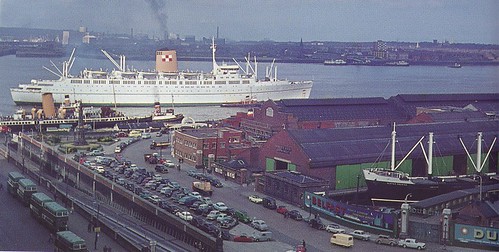I only recently discovered the website Historic Liverpool) with old maps and a blog run by Martin Greaney and Sue Greaney. They offer framed maps and Martin's book 'Liverpool: A Landscape History'. In the blog, there's a post 'Postcards from Edwardian Liverpool' and two of these particularly interested me.

Liverpool: Edwardian postcard view of Princes Dock, looking north, showing in the foreground the pump house where 'Lion' was used to empty the Princes Graving Dock seen immediately behind the pumphouse (Photo: 'Historic Liverpool')

Liverpool: Edwardian postcard view of Princes Dock, looking north, showing 4-funnel liner at the Landing Stage and New Brighton Tower in the background (Photo: 'Historic Liverpool')
Apart from the general interest of any old photographs, I found three features of special note.
Princes Graving Dock Pumping House
The first postcard shows the Graving Dock emptied and with a cargo vessel receiving attention. In the foreground, the pumping house where 'Lion' was used to drive the chain pump used to empty the Graving Dock is visible. The details are not too clear but, by reference to the 1873 drawing below, the elaborate chimney associated with the Pumping House is definitely visible.

Liverpool: Drawing of Princes Graving Dock Pumping House circa 1873 (National Museums & Galleries on Merseyside)
It's assumed that, following electrification of the Graving Dock pumping in the 1920s and donation of 'Lion' to the Liverpool Engineering Society, this chimney was demolished. Certainly, it's gone in the 1961 colour image I included in the post 'Lion' Locomotive - the Lost Years, copied below.

Liverpool Pierhead in 1961 with the 'Empress of Britain' dominating the scene. Of interest to rail enthusiasts is the rare view of the Pumphouse (to the left of the 'Belfast' hoarding) from where the locomotive 'Lion' was rescued (Photo: N.P.B. collection from 'Reflections on a River').
Click for larger view.
In 1992, National Museums & Galleries on Merseyside documented the remaining Pumping House in drawings and photographs prior to demolition. This information was published in 'Lionsheart', the newsletter of the Old Locomotive Committee (No. 29 April 1993, No. 31 Sep 1993 and No. 61 June 2005) and some of which is reproduced here. All issues of 'Lionsheart' are available online to Old Locomotive Committee members via the OLCO website here, which also includes membership application details.
Four funnel liner
The second postcard shows a four funnel steamship moored at Liverpool Landing Stage. I was intrigued about the identity of this ship and was surprised to discover that only 14 liners were ever built with 4 funnels.
Kaiser Wilhelm der Grosse (launched 1897, scuttled 1914)The above and much more can be found on the Maritime Quest website here which has a marvellous collection of historic photographs.
Deutschland (launched 1900, scrapped 1925)
Kronprinz Wilhelm (launched 1901, scrapped 1923)
Kaiser Wilhelm II (launched 1902, siezed by USA 1917 finally scrapped 1940)
Lusitania (launched 1906, torpedoed 1915)
Mauritania (launched 1906, scrapped 1935)
Kronprinzessin Cecilie (launched 1906, siezed by USA 1917 finally scrapped 1940)
France (launched 1910, scrapped 1935)
Olympic (launched 1910, scrapped 1935-1937)
Titanic (launched 1911, sank 1912)
Aquitania (launched 1913, scrapped 1950)
Britannic (launched 1914, mined 1916)
Arundel Castle (launched 1919, scrapped 1959)
Windsor Castle (launched 1921, torpedoed 1943)
This was the period when transatlantic companies vied to provide enhanced facilities to their First Class clientele. Of course, it wasn't just the rich and famous who travelled on these luxurious leviathans. Liverpool was the port of departure for many emigrants seeking a better life in the United States, usually travelling more modestly in 'Steerage' as Third Class was often called.
New Brighton Tower
In both the aboce postcards, New Brighton Tower is visible in the distance on the other side of the river. This tower, outlined in a Wikipedia article here had a fairly short existence (1898-1921), defining the possible range for the date of the two original photographs.
Following the success of Blackpool Tower, opened in 1894, New Brighton acquired its own tower in 1898. The tower itself (like Blackpool) surmounted an impressive brick-built ballroom. The tower was closed during World War I during which maintenance stopped and, after the war, it was decided to demolish the tower and sell the low carbon steel used in its construction for scrap. The Tower Ballroom remained in use until destroyed by fire in 1969.

New Brighton Tower (Photo: Historic England Archive)
Related posts on other websites
Lion & The Old Locomotive Committee (OLCO website)
Four Funnel Liners (Maritime Quest)
New Brighton Tower (Wikipedia)
Related Pumping House posts on this website
'Lion' and the Pumphouse
'Lion' Locomotive - the Lost Years
To find all my posts about the Old Locomotive Committee and the locomotive 'Lion', click here or select 'OLCO' under 'Labels to select a blog topic'.
To find all my posts on Liverpool, The Wirral and Merseyside, click here.
